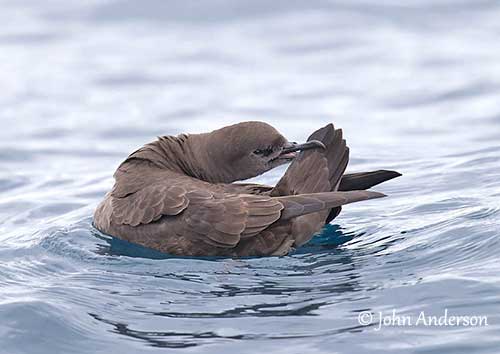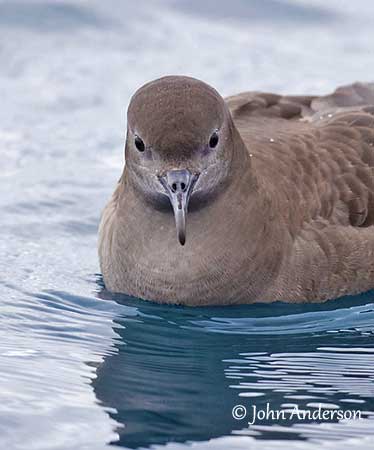
Fr: Puffin à bec grêle
Ang: Short-tailed Shearwater
All: Kurzschwanz-Sturmtaucher
Esp: Pardela de Tasmania
Ita: Berta codacorta
Nd: Dunbekpijlstormvogel
Sd: kortstjärtad lira
Photographers:
John Anderson
John Anderson Photo Galleries
Ken Havard
My Bird Gallery & Flickr gallery 1 & Flickr gallery 2
William Price
PBase-tereksandpiper & Flickr William Price
Text by Nicole Bouglouan
Sources:
HANDBOOK OF THE BIRDS OF THE WORLD vol 1 by Josep del Hoyo-Andrew Elliot-Jordi Sargatal - Lynx Edicions - ISBN: 8487334105
Australian Antarctic Division: Leading Australia's Antarctic Program
Wikipedia, the free encyclopaedia
Bird Web (Seattle Audubon Society)
Globetrotting shearwaters start huge migration from Phillip Island to northern hemisphere
Feeding ecology of short-tailed shearwaters: breeding in Tasmania and foraging in the Antarctic?
Alaska Seabird Information Series
What Bird-The ultimate Bird Guide (Mitchell Waite)
Short-tailed Shearwater
Ardenna tenuirostris
Procellariiformes Order – Procellariidae Family
INTRODUCTION:
The Short-tailed Shearwater is a dark seabird with narrow wings. It usually occurs in large flocks over cold waters. It is one of the most numerous shearwaters of the world.
It breeds on islands off S Australia and around Tasmania. It migrates every year, travelling further north than the closely related Sooty Shearwater, reaching the Aleutians through the Bering Sea into the Arctic Ocean.
The large population is locally increasing, but climate change may involve some decline. But currently, the Short-tailed Shearwater is not globally threatened.

DESCRIPTION OF THE BIRD:
Biometrics:
Length: 40-45 cm
Wingspan: 91-100 cm
Weight: 480-930 g
The Short-tailed Shearwater has blackish-brown plumage overall, except for the dull pale grey underwings. On the upperparts, it may appear slightly paler on hindneck, mantle and back, whereas the flight-feathers and the tail are darker brown. At close range, the plumage shows a slight scaly appearance, especially on scapulars.
The underparts are usually paler, including the pale grey underwing. However, some individuals may have almost plain brownish underwing.
It has long, pointed wings and short-rounded tail. The body is compact.
The head is darker than rest of plumage, giving sometimes capped appearance.
The bill is pale brownish to dark grey, often with darker tip. It is relatively short for a shearwater (32 x 11mm). The eyes are dark brown to blackish. Legs and feet are dark brownish grey.
Male and female have similar plumage, but the male is slightly larger than the female.
The juvenile resembles adult. It can be slightly darker with contrasting pale throat.
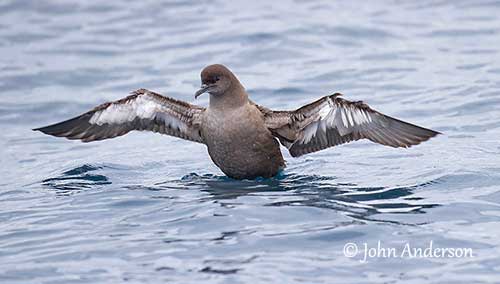
RANGE:
The Short-tailed Shearwater breeds in Tasmania and S Australia, especially in SE. This species occurs in Pacific Ocean and S Indian Ocean.
HABITAT:
The Short-tailed Shearwater is found in open ocean, with concentrations over the continental shelf and around the upwellings in cool waters.
It breeds on islands close to the shore, but also locally on Australian mainland. It favours soft soils covered with grass and shrubs where it can excavate the nesting burrow.
CALLS AND SONGS: SOUNDS BY XENO-CANTO
The Short-tailed Shearwater gives throaty “kooka-rooka” calls from the ground or inside the burrow. The rate of calling increases and the pitch rises, changing these calls to “koo-roo-rah”. These birds are usually silent in flight.
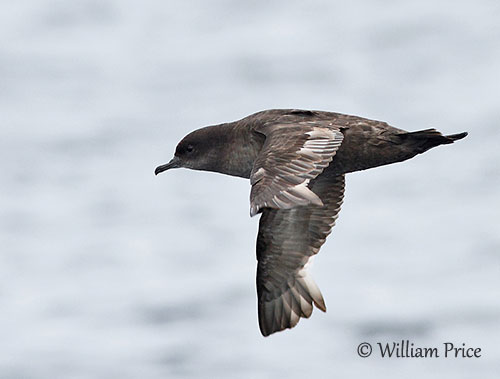
BEHAVIOUR IN THE WILD:
The Short-tailed Shearwater feeds primarily on crustaceans such as amphipods and shrimps of genus Euphausia, but it also takes fish, small octopus and squid, marine worms, jellyfish and insects. This diet varies according to the season and the range.
It catches the prey by plunging into the water or by diving from the surface. It uses its wings to propel itself through the water. It may pursue the prey and frequently reaches 20 metres depth, sometimes more. It also follows the boats for scavenging.
The Short-tailed Shearwater feeds in large flocks of up to 20,000 birds, usually with other shearwater species, cormorants and terns. It may also forages in association with whales and dolphins.
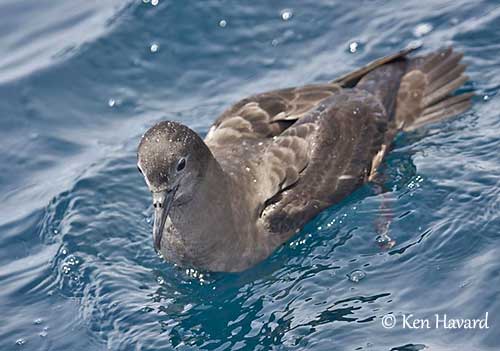
During the nesting period, the adults are able to convert this food to oil with has lower weight than the ingested food items, making easier the flight to return to the colony and feed the chick.
Displays are performed to strengthen the pair-bonds. They include head-waving, cackling display, mutual preening and sometimes mutual billing. They are monogamous.
Following mating, the birds perform a pre-laying exodus in order to gain weight prior to laying and incubation.
The Short-tailed Shearwater breeds in colonies where the birds are strictly nocturnal, in order to reduce the risk of predation. The adults defend an area around the burrow entrance. The colonies are usually densely packed.
The Short-tailed Shearwater is a long-distance migrant. It breeds around S and E Australia and Tasmania. It moves N through W Pacific in April/May after breeding. Concentrations occur off S Alaska during summer, but some birds move N through Bering Strait to Arctic Ocean.
They move S again in August/September, rapidly crossing the tropical waters. Non-breeding birds may remain off Pacific Coast of North America all the year.
The Short-tailed Shearwater is a good flier. It performs strong wingbeats interspersed with long glides. It often soars for long periods.
This species has been known to perform the one-way trip of more than 14,000 kilometres in about six weeks, thanks to the long, narrow wings.
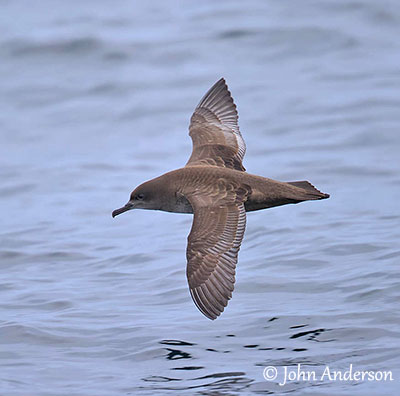
REPRODUCTION OF THIS SPECIES:
The nesting period occurs from September to April.
The Short-tailed Shearwater breeds in colonies on coastal islands, but also on mainland promontories overlooking the sea.
It nests in burrow excavated by both mates in soft soil, usually under grass or shrub. The pair usually returns to the same nest-site for several following years.
At the end of the burrow (83 to 185 cm long), the nest-chamber is lined (or not) with grasses.
The female lays a single white egg. Both adults incubate during 52-55 days. The chick is fed by both parents at night. It is fed by regurgitation of prey converted to energy-rich oil. As the chick is growing and becomes mature, the feeding visits are less frequent. The adults abandon the young bird which goes to the sea between 82 and 108 days after hatching.
Nesting failure may occur caused by Blue-tongue Lizard (Tiliqua nigrolutea) and water-rats (Hydromys chrysogaster), but heavy summer rainfall is also a significant threat of flooding.
PROTECTION / THREATS / STATUS:
The Short-tailed Shearwater is abundant and widespread. However, the species is vulnerable to over-harvesting, fisheries bycatch, predation and habitat destruction. As a long-distance migrant, it may be exposed to threats while travelling over such wide area.
The global population is estimated to number 23 million individuals, and about 285 colonies are known in SE Australia, with the largest one on Babel Island (off NE coast of Tasmania) with approximately 3 million burrows.
This population is suspected to be declining due to ecosystem change resulting from climate change.
But currently, the Short-tailed Shearwater is evaluated as Least Concern.
